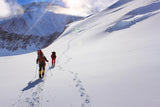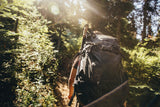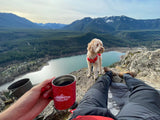What’s With the Pink Snow?: A Backcountry Ski Expedition in the Name of Science

Contributed by @paxtunz; top photo by @brandondev15
The cool air rushed down out of the gully’s opening. The trail quickly disappeared among the tumble of rocks and boulders strewn about. A stream coursed out from under the snout of the receding snowfield that was once known as Spider Glacier. I wasn’t sure whether the goosebumps were from the chill of the cool air or from my excitement. I made it. Within a few steps onto the snowfield, I found what I was looking for, the main reason I had come nine miles into the Glacier Peak Wilderness, the ancestral lands of the Chelan, Wenatchi, Entiat, Yakama and Okanagan peoples. Pink, living, snow.
Have you ever seen pink or red streaks of snow on glaciers or high snowfields? It’s actually algae growing on the snow and ice. You can find it in alpine ecosystems all over the world. These algal communities typically appear in the spring and summer as the snow pack melts. Beyond that though, we don’t know a whole lot, especially about the alpine algae here in Washington. However, there’s a group of scientists and volunteers working to deepen our understanding of these species, how they impact their ecosystems and ultimately our planet.



The base of the Spider Snowfield; M: Pink snow!; R: Transitioning to skis and skins. | Photos by @paxtunz
A few months before my trip, I stumbled onto The Living Snow Project, a citizen science project run by the Kodner Lab at Western Washington University. The project, headed up by Dr. Robin Kodner, seeks. . .
“. . .to engage the outdoor recreation community in research that is helping us understand the biology of pink snow and its impact on snowmelt dynamics. By empowering people of all ages to participate in science in the places they love to play, we help cultivate a deeper awareness of our living planet and a greater appreciation for the conservation of threatened ecosystems.” - The Living Snow Project
With limited funding, the project relies heavily on volunteers already planning to travel to high alpine ecosystems during the spring and summer to expand the lab’s sampling reach. The ask is simple, take a small sample kit and collect two samples of pink snow to send back to the lab. The weight penalty for taking the kit is small, maybe 18 ounces. The opportunity for an otherwise selfish and some would even say “useless” endeavor to be for a greater purpose, now that’s huge.

Spider Gap in July | Photo of @paxtunz by @brandondev15
The snow on the Spider snowfield was soft and sun cupped. It wouldn’t make for the best skiing but it would do for July. A cool breeze flowed down the narrow gully from the top of the col, Spider Gap. The snowfield had been a true glacier once, some many decades ago. Further up, in melt runnels, was more pink snow. Some patches were a bright, violent red. The air near those patches had a slightly sweet smell, a bit like watermelon, but faint, like you had just walked passed it at a summer farmer’s market.
The last stretch flattened out before steepening abruptly as the snow came briefly to an end. Off came the skis. As I walked to see what the other side of Spider Gap had been hiding, my jaw dropped. Laid out before me was an expanse of some of the most scenic wilderness I had ever seen in all of Washington. Magnificent peaks and alpine lakes as far as the eye could see.

Looking over to Lyman Glacier from the top of Spider Gap | Photo of @paxtunz by @brandondev15
I tried to savor the moment, noticing with detail the subtle sounds and visual textures around me: the sound of my bindings as they snapped into their downhill setting, the irregular and randomly sun cupped snow, my breath, the thud and squeak of my boots as I locked everything up. As I skied down to Upper Lyman Lake I gazed at what remained of the Lyman Glacier. It was split in two, a shadow of what it had once been.

Summer turns for science! | Photo of @paxtunz by @brandondev15
The pink snow crunched in the sample tube as I crammed it full with snow from the brightest patch I could find down by Upper Lyman Lake. I sealed the sample and on the side of the tube scribbled out in pen the date, location and GPS coordinates from my first sample.

Notice how the protocol doesn’t say not to eat the pink snow;) | Photos by @paxtunz

Sample secured | Photos by @paxtunz
Back up at Spider Gap my skins had taken on a pink hue. Skiing back down the snowfield I spotted the most vibrant red patch I had seen all day. It was almost blood red. Time to fill the second sample tube. As I crammed snow into the tube that was colored such a deep shade of red it looked like someone or something had bled to death here, I wondered how many years this algae had been blossoming here each spring? Was it part of a greater feedback loop of warming? I didn’t and still don’t have the answers to those questions but I know that the samples I took, have a shot at helping to piece together those answers. Let me tell you, that feels damn good.

After I got back from the trip I found photos of the glacier from back in 1900 (thanks to Lowell Skoog for being a regular TAY contributor). What a difference nearly a hundred and twenty years of humans pumping carbon into the atmosphere makes. According to the North Cascades Glacier Climate Project, Lyman Glacier retreated 1300m between 1907 and 2008. That’s a 76% loss in length, 88% loss in area and 91% loss in total volume. The glacier likely hasn’t seen growth since the end of the Little Ice Age, however, the warming due to human caused climate change has greatly hastened it’s retreat. Lyman isn’t expected to survive through 2050.
A recent study found that the presence of snow algae can potentially cause glacial snow and ice to melt faster. Other studies have found that black particles, a substance called Cryoconite, are accumulating on Greenland’s ice sheets and other glacial regions, driving a vicious cycle of glacial melting. Cryoconite is composed of some natural materials, but has contained increasing levels of black soot from coal fired power plants and auto emissions since the 1870’s. This darkening has in turn caused glaciers to darken. White snow and ice reflect heat from the sun. Soot stained glaciers absorb more of that heat, quickening the rate at which they melt in the summer.
I am by no means a perfect environmental advocate. I don’t drive a Prius. I have a gas stove in my apartment. I fly too much. I eat meat. I am part of the problem but perfect is the enemy of good. I have seen how human caused climate change is impacting our glaciers and our snow pack. I am making an effort to buy less, eat less meat, use less plastic, donate to organizations cultivating positive change, drive a more fuel efficient car and most importantly, vote for candidates that promise to protect our environment and tackle the climate issue.
Participating in the Living Snow Project is an opportunity to be involved and to directly drive progress on a piece of the science around our climate and environment. Learn more and sign up to volunteer for the Spring 2020 season at the project’s website - here

Lyman Glacier, July, 2019 | Photo by @brandondev15




